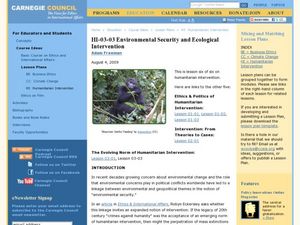Curated OER
Urban Ecosystems 2: Why are There Cities? A Historical Perspective
Second in a series of five lessons, this lesson encourages preteens to consider cities as urban ecosystems. First, they keep a food diary for a few days. They visit the Natrional Agricultural Statistics Service website for current data...
Curated OER
Week 3: Pollution Source and Effects
Lab groups set up an experiment to observe what happens over time in collected pond water when fertilizer, representing pollution, is added. This website does not include student lab sheets, but background information, materials, and...
Curated OER
Soybeans: The Miracle Seed
Students discover why soybeans are called the "miracle seeds." They make their own soynuts and share other foods made from soybeans. They create a bulletin board of soybean products.
Curated OER
Adaptation Worksheet
Adaptation or acclimation? Young ecologists determine which is being exemplified in twenty questions. When teaching about adaptations, make sure to talk about acclimation, a short-term learned response to a change in the surroundings....
Curated OER
Composting
Using 2-liter bottles, junior ecologists create composting tubes in which they place nitrogen-rich and carbon-rich materials. They observe what changes occur over two weeks' time. Provide more specific direction to your class as to what...
Curated OER
Environmental Security and Ecological Intervention
Students examine environmental changes . For this investigative lesson students view a film then complete and activity that includes a debate.
Curated OER
The Human Mind
Young scholars read and discuss twin studies to explore the debate of nature vs. nurture. They create a list of characteristics and then look for evidence of whether it is primarily a genetic or environmental characteristic. All of the...
Curated OER
How Do We Balance Environmental Conservation with Human Needs?
Learners role play a meeting between conservation biologists and local representatives who want to advance the livelihood of local population. In this history instructional activity, students research the necessities and conservation...
Curated OER
Environmental Education (Grade 4 - Lesson 2)
Fourth graders discuss ways in which the environment is helpful to humans. They discover how their actions affect the environment. They identify how animals and humans are subjected to the same environmental conditions.
Curated OER
Environmental Hazards
Students identify environmental hazards on a simulated field trip. They analyze the exposure and suggest methods to eliminate or reduce exposure to toxic sources.
Curated OER
The Human Face of Flagstaff
Students make a brochure for Flagstaff, Arizona. In this geography lesson, students look at a map of Arizona and the Flagstaff Chamber of Commerce sheet to find natural and human features of the city. They create a brochure describing...
Curated OER
Climate Change
Students explore environmental care by researching the impact of human beings on our planet. For this climate change lesson, students utilize the Internet to read informational text about climate change and the effect it will have on our...
Curated OER
Human Activity and the Environment 2004
Learners brainstorm the ways we use energy sources in our daily lives and what our lives would be like without it. They answer questions based on sections from the Human Activity and the Environment 2004, "Energy in Canada" article.
Curated OER
Conservation and Environmental Protection
Students brainstorm a list of environments and animals from around the world that need protection. They then design and create a slogan about an animal or environment and an environmental protection poster.
Curated OER
Natural Hazards Research Paper and Oral Presenation
Students use the internet and look at a list of the world's countries and the natural hazards that impact them. They comprehend that it is sometimes called "Nature's Fury," each natural hazard has a heartbeat, a locational pattern, and a...
Curated OER
Natural Disasters
Students compose essays outlining the effects of floods on humans and their environments. Included in their essays are methods explaining how people have tried to adapt to floods. Using the Internet or provided written materials,...
Curated OER
Nature Reflections
Middle schoolers have a greater appreciation for the nature around them. They participate in a series of reflection exercises. Students encounter blindfolds, and bandannas with cardboards as bases.
Curated OER
Human Activity and Cllimate Change
Learners perform activities to explore the affect of human activity on climates. They examine graphs of GHG emissions and their increases that are associated with human activity. Using a Global Climate Changing website, students explore...
PBS
Technology: Conveniences and Consequences
It's a delicate balance—using technology to improve our lives while still protecting the environment, and ourselves, from the hazards of technology use. Class members examine statistics about the increase in media use, complete a survey...
Curated OER
Interactions Everywhere!
Young scholars examine interactions within the environment and environmental engineering careers. They discuss and view photos of natural and manmade environments, explore various websites, create a web to identify interactions between...
Curated OER
Our Population and Its Impact on the Planet
Students explore environmental problems due to the growing worldwide human population and examine the growth rate. They also discuss possible ways to stabilize population growth and increase sustainable development.
Curated OER
Ecology
Students make connections between their daily lives and the usage of natural resources as they relate to the importance of environmental quality. In this ecology lesson, students listen to the story The Lorax by Dr. Seuss and then...
Curated OER
Models as Tools for Ecosystem Management
Fifth graders explore the concept of environmental management. For this ecosystem lesson, 5th graders discover how models help scientists learn more about managing ecosystems. Students create their own model, make observations and...
Curated OER
Mapping School Grounds
Learners map and analyze the natural and cultural environment of the school grounds. In small groups, they sketch the natural and cultural features of each side of the school building, create a map, participate in a class discussion,...

























